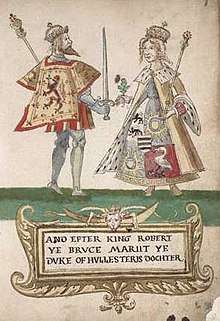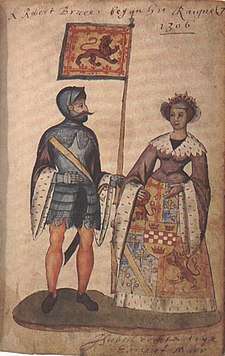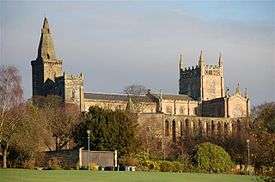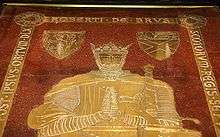Elizabeth de Burgh
Elizabeth de Burgh (c. 1289– 27 October 1327) was the second wife and the only queen consort of King Robert the Bruce. Elizabeth was born sometime around 1289, probably in Down or Antrim in Ireland.[1] She was the daughter of one of the most powerful Irish nobles of the period, Richard Óg de Burgh, 2nd Earl of Ulster, who was a close friend and ally of Edward I of England.
| Elizabeth de Burgh | |
|---|---|
 Robert the Bruce and Elizabeth de Burgh, from the Seton Armorial. | |
| Queen consort of Scotland | |
| Tenure | 1306–1327 |
| Coronation | 27 March 1306 |
| Born | c. 1289 County Down or County Antrim |
| Died | 27 October 1327 Cullen, Banffshire |
| Burial | |
| Spouse | Robert I of Scotland |
| Issue | Matilda Margaret David II of Scotland John of Scotland |
| House | de Burgh |
| Father | Richard Óg de Burgh, 2nd Earl of Ulster |
| Mother | Margarite de Burgh |
Not much is known about Elizabeth, despite her husband's status as one of the most famous Scottish kings and warriors. As is the case with most medieval women, records of Elizabeth are scarce; however, it is clear that she was caught up in the political turmoil that unfolded between the Scottish and the English during the reign of her husband King Robert, had to move several times to keep safe, and was eventually seized as a prisoner.
Life
She was born in Ireland (c. 1284), the daughter of the powerful Richard Óg de Burgh, 2nd Earl of Ulster and his wife, Margarite de Burgh (died 1304). Her father was a close friend of King Edward I of England.
Elizabeth probably met Robert the Bruce, then Earl of Carrick, at the English court, By the time they married in 1302 at Writtle, near Chelmsford, Essex, England Robert was a widower with a young daughter from his first marriage. Elizabeth would have been about 18 years old, and Robert 28.
On 27 March 1306, Robert and Elizabeth were crowned as King and Queen of Scots at Scone. The coronation took place in defiance of the English claims of suzerainty over Scotland after the execution of Sir William Wallace. After his coronation, she is quoted as having said,
Alas, we are but king and queen of the May!
as though anticipating a defeat by Edward I.[2]
Capture
After the defeat of the Scots at the Battle of Methven on 19 June 1306, the king sent Elizabeth, his daughter Marjorie by his first marriage, his sisters Mary and Christina to Kildrummy Castle, under the protection of his brother Niall (also known as Nigel).[3]
The English laid siege to the castle containing the royal party. The siege finally succeeded when the English bribed a blacksmith with "all the gold he could carry" to set fire to the grain store. The victors hanged, drew and quartered Niall Bruce,[4] along with all the men from the castle. However, the royal ladies under the escort of the Earl of Atholl had already fled.
They were taken from the sanctuary of St. Duthac at Tain by the Earl of Ross, a supporter of the Comyns, and dispatched to King Edward. He imprisoned Bruce's sister Mary and Isabella MacDuff, Countess of Buchan, in wooden cages erected on the walls of Roxburgh and Berwick castles respectively, and then sent Bruce's nine-year-old daughter Marjorie to the nunnery at Watton.
Elizabeth was held under severe conditions of house arrest in England while Edward still needed aid from her father. The Earl of Atholl was hanged and his head displayed on London Bridge.[5]
She was imprisoned for eight years by the English. From October 1306 to July 1308 she was held at Burstwick-in-Holderness, Yorkshire, where she, only served by two elder women, wrote a letter complaining about her condition (she had only 3 clothes and no headgear or linen bed clothing), before being transferred to Bisham Manor, Berkshire until March 1312. From there, she was moved to Windsor Castle with six attendants and an allowance, where she was held until October 1312, Shaftesbury Abbey, Dorset until March 1313, Barking Abbey, Essex until March 1314, and Rochester Castle, Kent until June 1314. After the Battle of Bannockburn, she was moved to York while prisoner exchange talks took place. At York, she had an audience with King Edward II of England. Finally, in November 1314, she was moved to Carlisle just before the exchange and her return to Scotland.
Elizabeth had three children who reached adulthood: Matilda, Margaret, and David (the future king David II of Scotland).[6][7]

Death
Elizabeth died aged around 43, on 27 October 1327 after falling from her horse during a visit to the royal residence at Cullen, Banffshire.[1][8]
Plans were immediately made to transport her body to Dunfermline Abbey in Fife, the resting place of Scottish kings and queens since 1093. As parishioners in Cullen were worried that her remains would not arrive intact they took the step of having her internal organs removed during the embalming process. While some sources claim that her entrails were transported separately to Fife, [8] others state that they were buried in the parish church of Cullen. [9] The parishioners also had Masses said to pray for her soul .[10]

Robert in gratitude for the treatment of Elizabeth's body and its return south for burial decreed that a chaplaincy be established at the Auld Kirk of Cullen (parish church of Cullen) and paid in perpetuity the sum of five Scots pounds to have Masses said for the soul of Elizabeth.[1][11][12] Robert's original bequest was augmented by Mary Queen of Scots in 1543 and continued to be paid by different bodies throughout the centuries until changes and loss of records due to local government reform in 1975, led to the stopping of payments.[10] In 2011 the church's minister, the Rev Melvyn Wood applied to the Moray Council to have the tradition re-instated and after a lengthy investigation the Council agree to reinstate the annual payment of £2.10[8] and even agreed to pay for the missed instalments.[10] A prayer is now said in the queen's honour at a Sunday service which also remembers parishioners who have died in the last year.[10]
When Robert died 18 months later his body was laid to rest next to Elizabeth who had been interred in the very centre of the abbey beneath the high altar, in an alabaster tomb decorated with gold leaf.[13] Fragments of the tomb still remain and can be seen in the National Museum of Scotland.[14] The abbey was sacked in 1560 by Calvinists during the Scottish Reformation and the tomb was lost, however King Robert's coffin was rediscovered in 1819 during construction work on the new abbey and Elizabeth's coffin was rediscovered in 1917. Both were re-interred in the new abbey.[15]

Issue
| Name | Birth | Death | Notes |
|---|---|---|---|
| Margaret | 30 March 1346 in childbirth | Married William de Moravia, 5th Earl of Sutherland and had one son, John (1346–1361), who died aged twenty of the Black Death. [16] | |
| Matilda (Maud) | 30 July 1353 | Married Thomas Isak/Isaac and had two daughters, Joanna (wife of John Gallda MacDougall) and Catherine.[16] Buried at Dunfermline Abbey | |
| David | 5 March 1324 | 22 February 1371 | King of Scots (1329 – 1372). Married (1) in 1328 Joan of England; no issue; married (2) in 1364 Margaret Drummond; no issue. |
| John | 5 March 1324 | October 1327 Dunfermline Palace, Fife | Younger twin brother of David II. Heir to the Crown of Scotland. [17][18] |
| Elizabeth Bruce | Unknown | After 1364 | Married Sir Walter Oliphant of Aberdalgie and Dupplin. |
Ancestry
| Ancestors of Elizabeth de Burgh | |||||||||||||||||||||||||||||||||||||||||||||||||||||||||||||||||||||||||||||||||||||||||||||||||||||||||||||||||||||||||||||||||||||||||||||||||||||||||||||||||||||||||||||||||||||||||||||||||||||||||||||||||||||||||||||||||||||||||||||||||||||||||||||||||||||||||||||||||||||||||
|---|---|---|---|---|---|---|---|---|---|---|---|---|---|---|---|---|---|---|---|---|---|---|---|---|---|---|---|---|---|---|---|---|---|---|---|---|---|---|---|---|---|---|---|---|---|---|---|---|---|---|---|---|---|---|---|---|---|---|---|---|---|---|---|---|---|---|---|---|---|---|---|---|---|---|---|---|---|---|---|---|---|---|---|---|---|---|---|---|---|---|---|---|---|---|---|---|---|---|---|---|---|---|---|---|---|---|---|---|---|---|---|---|---|---|---|---|---|---|---|---|---|---|---|---|---|---|---|---|---|---|---|---|---|---|---|---|---|---|---|---|---|---|---|---|---|---|---|---|---|---|---|---|---|---|---|---|---|---|---|---|---|---|---|---|---|---|---|---|---|---|---|---|---|---|---|---|---|---|---|---|---|---|---|---|---|---|---|---|---|---|---|---|---|---|---|---|---|---|---|---|---|---|---|---|---|---|---|---|---|---|---|---|---|---|---|---|---|---|---|---|---|---|---|---|---|---|---|---|---|---|---|---|---|---|---|---|---|---|---|---|---|---|---|---|---|---|---|---|---|---|---|---|---|---|---|---|---|---|---|---|---|---|---|---|---|---|---|---|---|---|---|---|---|---|---|---|---|---|---|---|---|
| |||||||||||||||||||||||||||||||||||||||||||||||||||||||||||||||||||||||||||||||||||||||||||||||||||||||||||||||||||||||||||||||||||||||||||||||||||||||||||||||||||||||||||||||||||||||||||||||||||||||||||||||||||||||||||||||||||||||||||||||||||||||||||||||||||||||||||||||||||||||||
See also
References
- "Elizabeth". www.oxforddnb.com.
- Lang, Andrew, "A history of Scotland from the Roman Occupation"
- Marshall, Rosalind K. (2003). Scottish Queens, 1034–1714. Tuckwell Press. p. 34.
- "Elizabeth de Burgh and Marjorie Bruce". Education Scotland. n.d. Archived from the original on 11 July 2015. Retrieved 11 July 2015.
- Scott, Ronald McNair, Robert the Bruce, King of the Scots, p. 87
- Bingham, Caroline Robert the Bruce
- Boardman, Stephen The Early Stewart Kings
- "Scots church enjoys Robert the Bruce funds - 700 years on". The Scotsman. 30 October 2016. Retrieved 3 May 2019.
- "RBH Biography: Elizabeth De Burgh, Queen of Scots (d. 1327)". www.berkshirehistory.com.
- "Bruce prayers cash reinstated". The Herald. 2 July 2014. Retrieved 3 May 2019.
- "History of Cullen and Deskford Church of Scotland". www.cullen-deskford-church.org.uk.
- Mackay, David (29 October 2016). "Robert the Bruce died 700 years ago… But he's still paying £5 to this church every year". The Press and Journal. Retrieved 7 May 2019.
- Macnamee, Colm (2006), Robert Bruce: Our Most Valiant Prince, King and Lord, Edinburgh: Birlinn, ISBN 978-1-84158-475-1. p. 271.
- Main, Ian Brooks; Sven Edge; Xabier Garcia; Jamie Wheeler; Andy. "National Museums of Scotland - Fragment of the tomb of Robert the Bruce". nms.scran.ac.uk.
- "Scottish Royal Burial Sites". Unofficial Royalty.
- Weir, Alison (2008). Britain's Royal Families, the Complete Genealogy. London: Random House. p. 211. ISBN 978-0099539735.
- Webster, Bruce (2004). "David II (1324–1371)". Oxford Dictionary of National Biography. Oxford: Oxford University Press. doi:10.1093/ref:odnb/3726.
- Penman, Michael (2008). Diffinicione successionis ad regnum Scottorum: royal succession in Scotland in the later middle ages., p. 20. In: Making and breaking the rules: succession in medieval Europe, c. 1000- c.1600. Turnhout: Brepols.
External links
| Wikimedia Commons has media related to Elizabeth de Burgh. |
| Scottish royalty | ||
|---|---|---|
| Preceded by Yolande de Dreux |
Queen consort of Scotland 1306–1327 |
Succeeded by Joan of The Tower |